light CHEVROLET CAVALIER 1998 3.G Owners Manual
[x] Cancel search | Manufacturer: CHEVROLET, Model Year: 1998, Model line: CAVALIER, Model: CHEVROLET CAVALIER 1998 3.GPages: 400, PDF Size: 20.74 MB
Page 8 of 400
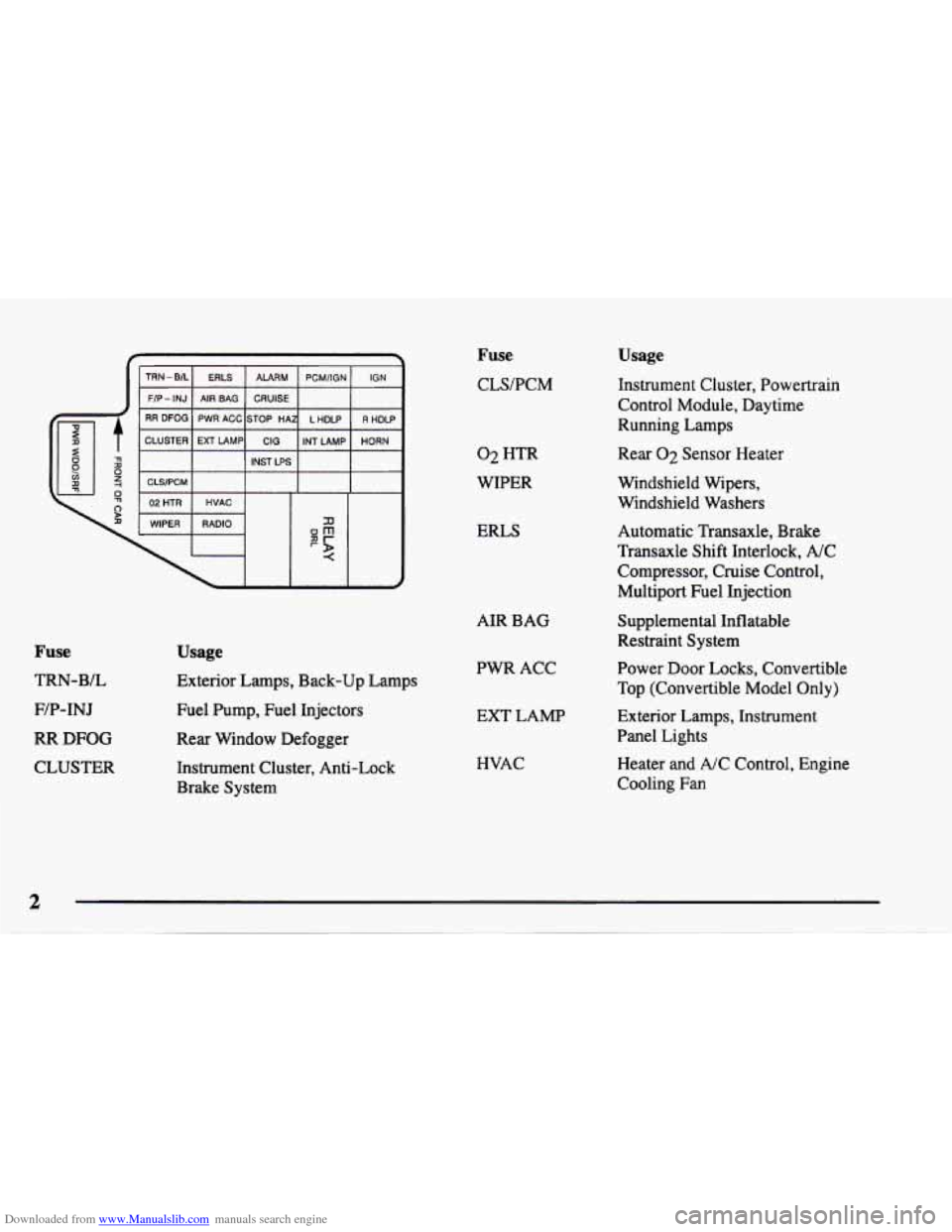
Downloaded from www.Manualslib.com manuals search engine Fuse
TRN-BL
F/P-INJ
RR
DFOG
CLUSTER
I TRN-BIL~ ERLS 1 ALA;' PCMIIGN I IGN 1
FIP- INJ AIR BAG CRUISE
RR DFOG PWR ACC STOP HA L HDLP R HDLP
CLUSTER EXT LAMP INT LAMP
HORN
I I I INST LPS I I I
I I I I
I 02 HTR I HVAC I I I I
1
WIPER RADIO
Usage
Exterior Lamps, Back-up Lamps
Fuel Pump, Fuel Injectors
Rear Window Defogger
Instrument Cluster, Anti-Lock
Brake System
Fuse
CLS/PCM
02 HTR
WIPER
ERLS
AIR BAG
PWR ACC
EXT LAMP
HVAC
Usage
Instrument Cluster, Powertrain
Control Module, Daytime
Running Lamps
Rear
02 Sensor Heater
Windshield Wipers,
Windshield Washers
Automatic Transaxle, Brake
Transaxle Shift Interlock, A/C
Compressor, Cruise Control,
Multiport Fuel Injection
Supplemental Inflatable
Restraint System
Power Door Locks, Convertible
Top (Convertible Model Only)
Exterior Lamps, Instrument
Panel Lights
Heater and NC Control, Engine
Cooling
Fan
Page 9 of 400
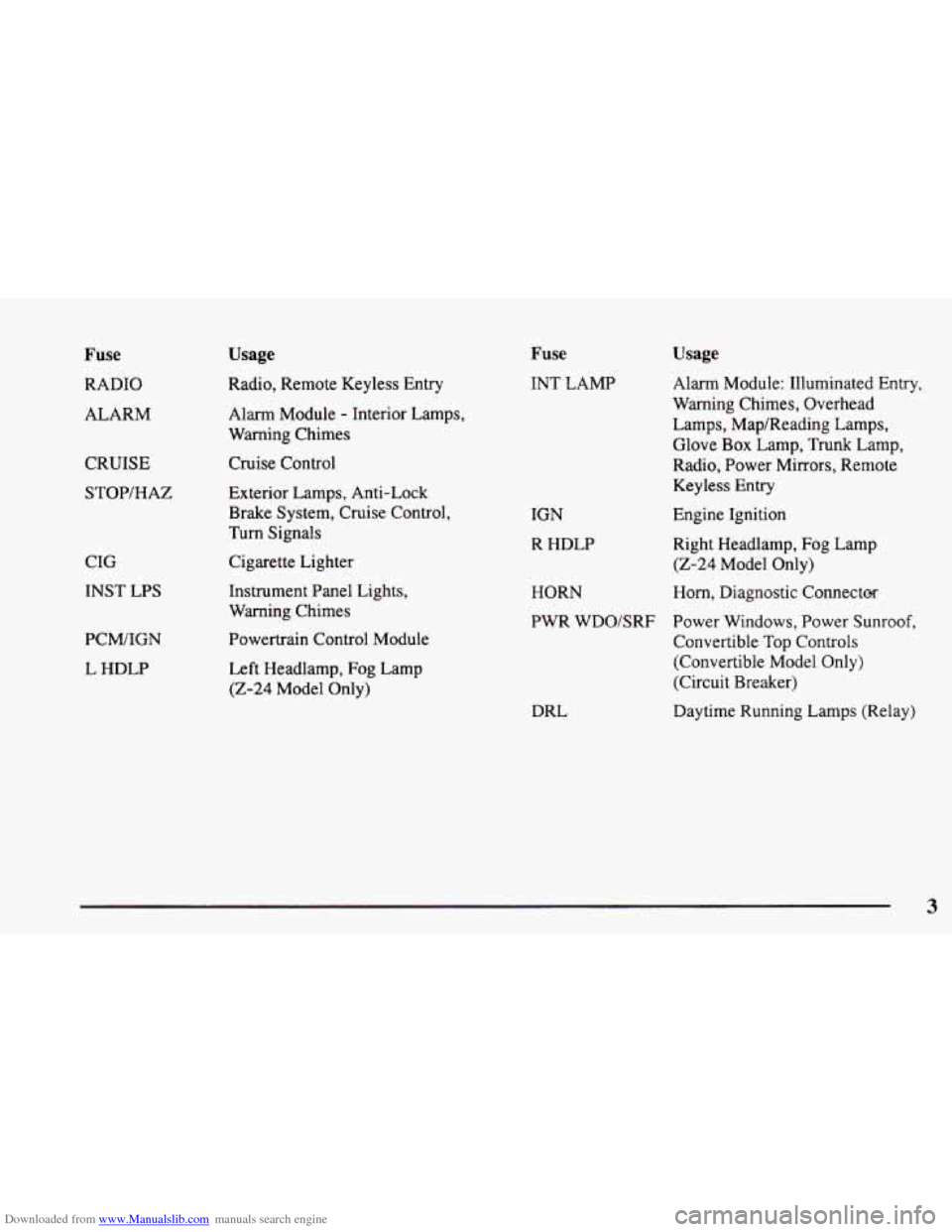
Downloaded from www.Manualslib.com manuals search engine Fuse
RADIO
ALARM
CRUISE
STOP/HAZ
CIG
INST LPS
PCWIGN
L HDLP
Usage
Radio, Remote Keyless Entry
Alarm Module
- Interior Lamps,
Warning Chimes
Cruise Control
Exterior Lamps, Anti-Lock
Brake System, Cruise Control,
Turn Signals
Cigarette Lighter
Instrument Panel Lights,
Warning Chimes
Powertrain Control Module
Left Headlamp, Fog Lamp
(2-24 Model Only)
Fuse
INT LAMP
IGN
R HDLP
HORN
Usage
Alarm Module: Illuminated Entry,
Warning Chimes, Overhead
Lamps, Map/Reading Lamps,
Glove
Box Lamp, Trunk Lamp,
Radio, Power Mirrors, Remote
Keyless
Entry
Engine Ignition
Right Headlamp, Fog Lamp
(2-24 Model Only)
Horn, Diagnostic Connectm
PWR WDO/SRF Power Windows, Power Sunroof,
Convertible Top Controls
(Convertible Model Only)
(Circuit Breaker)
DRL Daytime Running Lamps (Relay)
3
Page 10 of 400

Downloaded from www.Manualslib.com manuals search engine Engine Compartment Fuse Block
The engine compartment fuse block is located on the
driver's side
of the engine compartment. Lift off the
cover
to check the fuses.
4
Fuse
IGN
BATT
1
BATT 2
ABS
COOLING FAN
BLO
PCM
A/C
ABS/EVO
Usage
Ignition Switch Circuits
Power ACC/Stoplamp Circuits Lighting Circuits
Anti-Lock Brake System
Engine Cooling Fan
Heater
and A/C Blower
Powertrain Control Module
A/C Compressor
Anti-Lock Brake System
Page 18 of 400

Downloaded from www.Manualslib.com manuals search engine Vehicle Symbols
These are some of the symbols you may find on your vehicle.
For example,
these symbols are used on an
original battery:
POSSIBLE A
CAUTION
INJURY
PROTECT EYES BY
SHIELDING
CAUSTIC
ACID COULD BAlTERY
CAUSE
BURNS
AVOID
SPARKS OR FLAMES
SPARK
OR ,111,
COULD FLAME
EXPLODE BAITERY
These symbols
are important
for you and
your passengers whenever your
vehicle is
driven:
DOOR LOCK
UNLOCK
n
WINDOW ISJ
These symbols
have to do with
your lamps:
RUNNING 0
DAYTIME -0 0
LAMPS '**
FOG LAMPS $0
These symbols
are on some of
your controls:
WINDSHIELD
DEFROSTER
WINDOW
DEFOGGER
VENTILATING FAN
These symbols
are used on
warning and
indicator lights:
CHARGING BAllERY
SYSTEM
BRAKE
(a)
COOLANT a
ENGINE OIL
PRESSURE
ANTI-LOCK
(a)
BRAKES
Here are some
other symbols
you may see:
FUSE
LIGHTER
n
HORN )tr
SPEAKER
b
FUEL p3
1
viii
Page 26 of 400
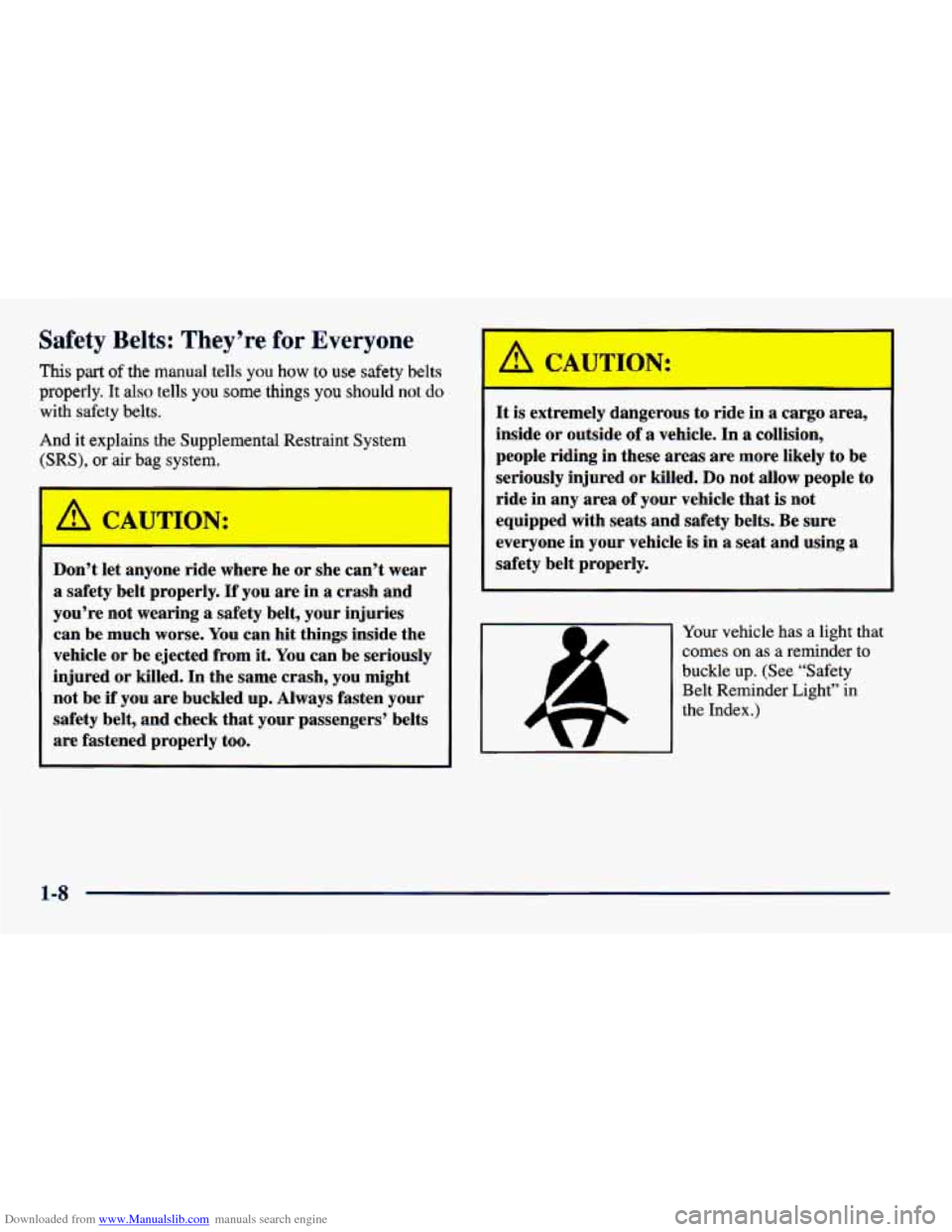
Downloaded from www.Manualslib.com manuals search engine Safety Belts: They’re for Everyone
This part of the manual tells you how to use safety belts
properly. It also tells you some things you should not do
with safety belts.
And
it explains the Supplemental Restraint System
(SRS), or air bag system.
A CAUTION:
- --
Don’t let anyone ride where he or she can’t wear
a safety belt properly. If you are in a crash and
you’re not wearing
a safety belt, your injuries
can be much worse. You can hit things inside the
vehicle or be ejected from it. You can be seriously
injured or killed. In the same crash, you might
not be
if you are buckled up. Always fasten your
safety belt, and check that your passengers’ belts
are fastened properly
too.
r:ezrz:us to ride in a cargo area,
~ inside or outside of a vehicle. In a collision,
~ people riding in these areas are more likely to be
seriously injured or killed.
Do not allow people to
ride in any area of your vehicle that
is not
equipped with seats and safety belts. Be sure
everyone in your vehicle is in
a seat and using a
safety belt properly.
-- - -- -
Your vehicle has a light that
comes on as a reminder to
buckle
up. (See “Safety
Belt Reminder Light” in
the Index
.)
1-8
Page 32 of 400

Downloaded from www.Manualslib.com manuals search engine Driver Position
This part describes the driver’s restraint system.
Lap-Shoulder Belt
The driver has a lap-shoulder belt. Here’s how to wear
it
properly.
1. Close and lock the door.
2. Adjust the seat (to see how, see “Seats” in the Index)
so you can sit up straight.
3. Pick up the latch plate and pull the belt across you.
Don’t let it get twisted.
The shoulder belt may lock
if you pull the belt across
you very quickly.
If this happens, let the belt go back
slightly to unlock it. Then pull the belt across you
more slowly.
4. Push the latch plate into the buckle until it clicks.
1-14
Page 42 of 400

Downloaded from www.Manualslib.com manuals search engine I
Air bags inflate with great force, faster than the
blink of an eye.
If you’re too close to an inflating
air bag,
it could seriously injure you. This is true
even
if your vehicle has reduced-force frontal air
bags. Safety belts help keep you in position before
and during a crash. Always wear your safety belt,
even with reduced-force air bags. The driver
should sit
as far back as possible while still
maintaining control of the vehicle.
Children who are up against, or very close to, an
air bag when it inflates can be seriously injured
or killed. This is true even if your vehicle has
reduced-force frontal
air bags. Air bags plus
lap-shoulder belts offer the best protection for
CAUTION: (Continued) adults,
but not
for young children and infants.
Neither the vehicle’s safety belt system nor its
air
bag system is designed for them. Young children
and infants need the protection that
a child
restraint system can provide. Always secure
children properly in your vehicle.
To read how,
see the part of this manual called “Children” and
see the caution labels on the sunvisors and the
right front passenger’s safety belt.
There is an air bag
readiness light
on the
instrument panel, which
shows AIR BAG.
AIR
BAG
The system checks the air bag electrical system for
malfunctions. The light tells you if there is an electrical
problem. See “Air Bag Readiness Light” in the Index
for more information.
1-24
Page 48 of 400
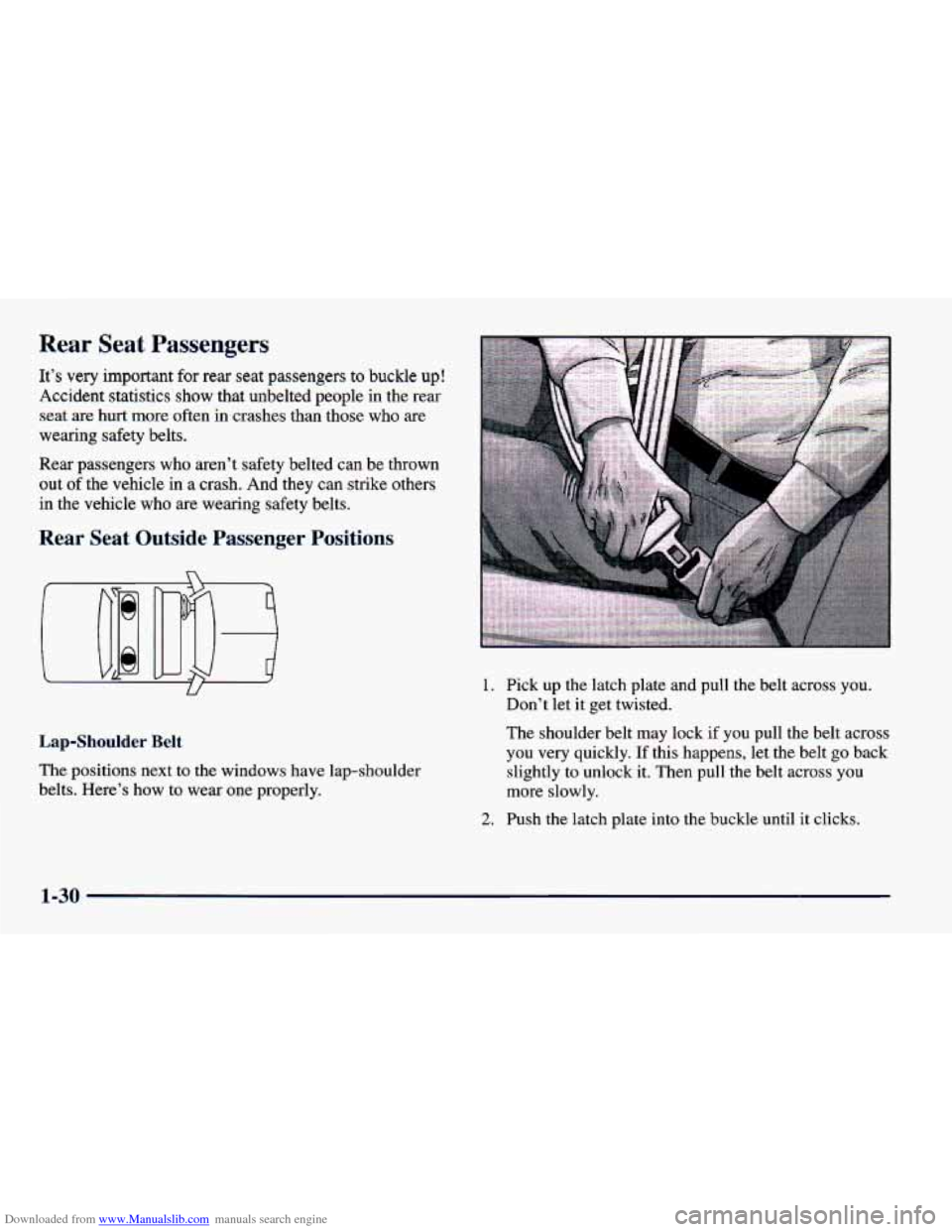
Downloaded from www.Manualslib.com manuals search engine Rear Seat Passengers
It’s very important for rear seat passengers to buckle up!
Accident statistics show that unbelted people in the rear
seat
are hurt more often in crashes than those who are
wearing safety belts.
Rear passengers who aren’t safety belted can be thrown
out of the vehicle in a crash. And they can strike others
in the vehicle who are wearing safety belts.
Rear Seat Outside Passenger Positions
Lap-Shoulder Belt
The positions next to the windows have lap-shoulder
belts. Here’s how to wear one properly.
1. Pick up the latch plate and pull the belt across you.
Don’t let it get twisted.
The shoulder belt may lock if you pull the belt across
you very quickly.
If this happens, let the belt go back
slightly to unlock it. Then pull the belt across you
more slowly.
2. Push the latch plate into the buckle until it clicks.
1-30
Page 73 of 400
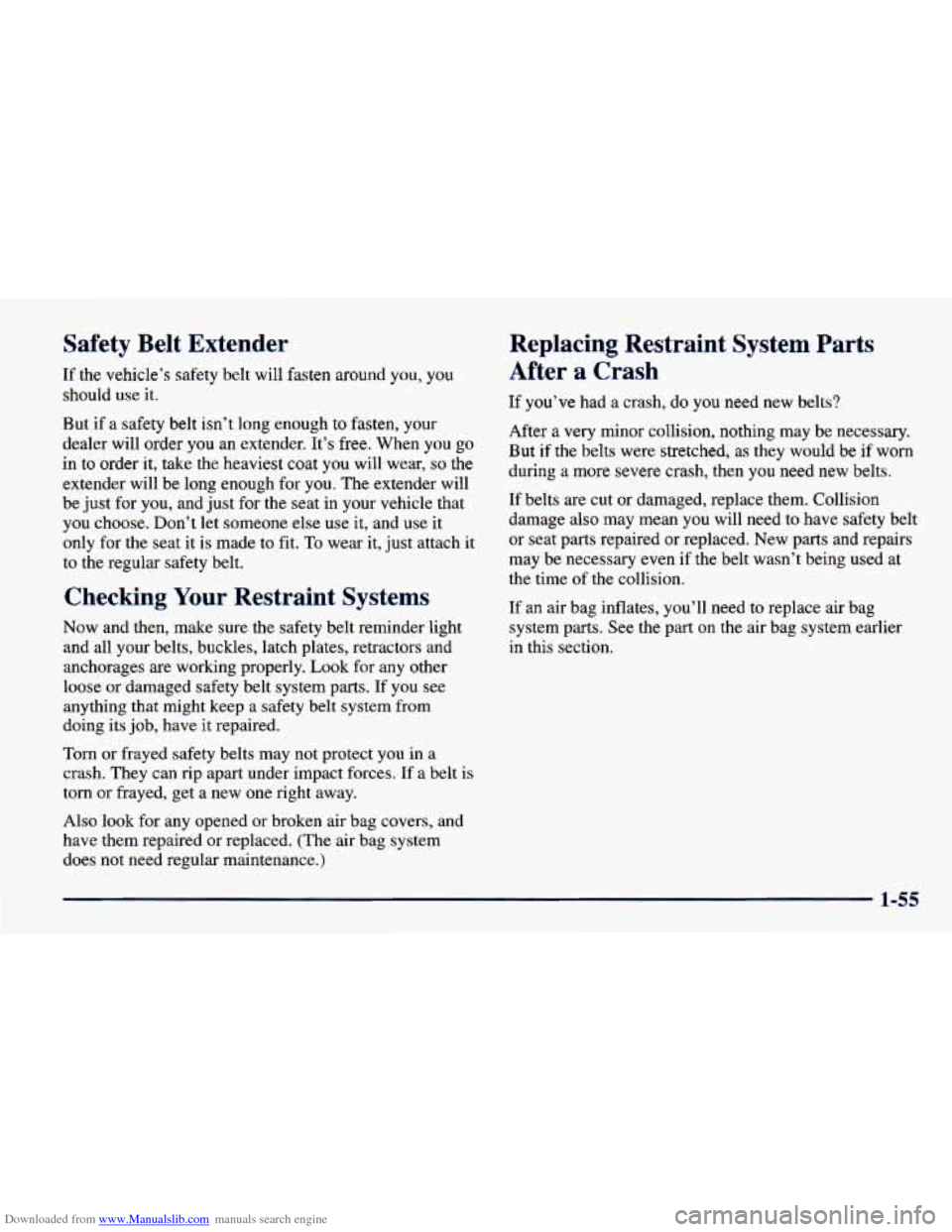
Downloaded from www.Manualslib.com manuals search engine Safety Belt Extender
If the vehicle’s safety belt will fasten around you, you
should use it.
But if a safety belt isn’t long enough to fasten, your
dealer will order
you an extender. It’s free. When you go
in to order it, take the heaviest coat you will wear, so the
extender will be long enough for you. The extender will
be just for you, and just for the seat in your vehicle that
you choose. Don’t let someone else use it, and use it
only for the seat it is made to fit. To wear it, just attach it
to the regular safety belt.
Checking Your Restraint Systems
Now and then, make sure the safety belt reminder light
and all your belts, buckles, latch plates, retractors
and
anchorages are working properly. Look for any other
loose or damaged safety belt system parts. If you see
anything that might keep
a safety belt system from
doing its job, have it repaired.
Torn or frayed safety belts may not protect you in a
crash. They can rip apart under impact forces. If a belt is
torn or frayed, get a new one right away.
Replacing Restraint System Parts
After
a Crash
If you’ve had a crash, do you need new belts?
After
a very minor collision, nothing may be necessary.
But if the belts were stretched, as
they would be if worn
during a more severe crash, then you need new belts.
If belts are cut or damaged, replace them. Collision
damage also may mean you will need to have safety belt
or seat parts repaired or replaced. New parts
and repairs
may be necessary even if the belt wasn’t being used at
the time of the collision.
If an air bag inflates, you’ll need to replace air bag
system parts. See the part
on the air bag system earlier
in this section.
Also look for any opened or broken air bag covers, and
have them repaired or replaced. (The air bag system
does not need regular maintenance.)
1-55
Page 77 of 400
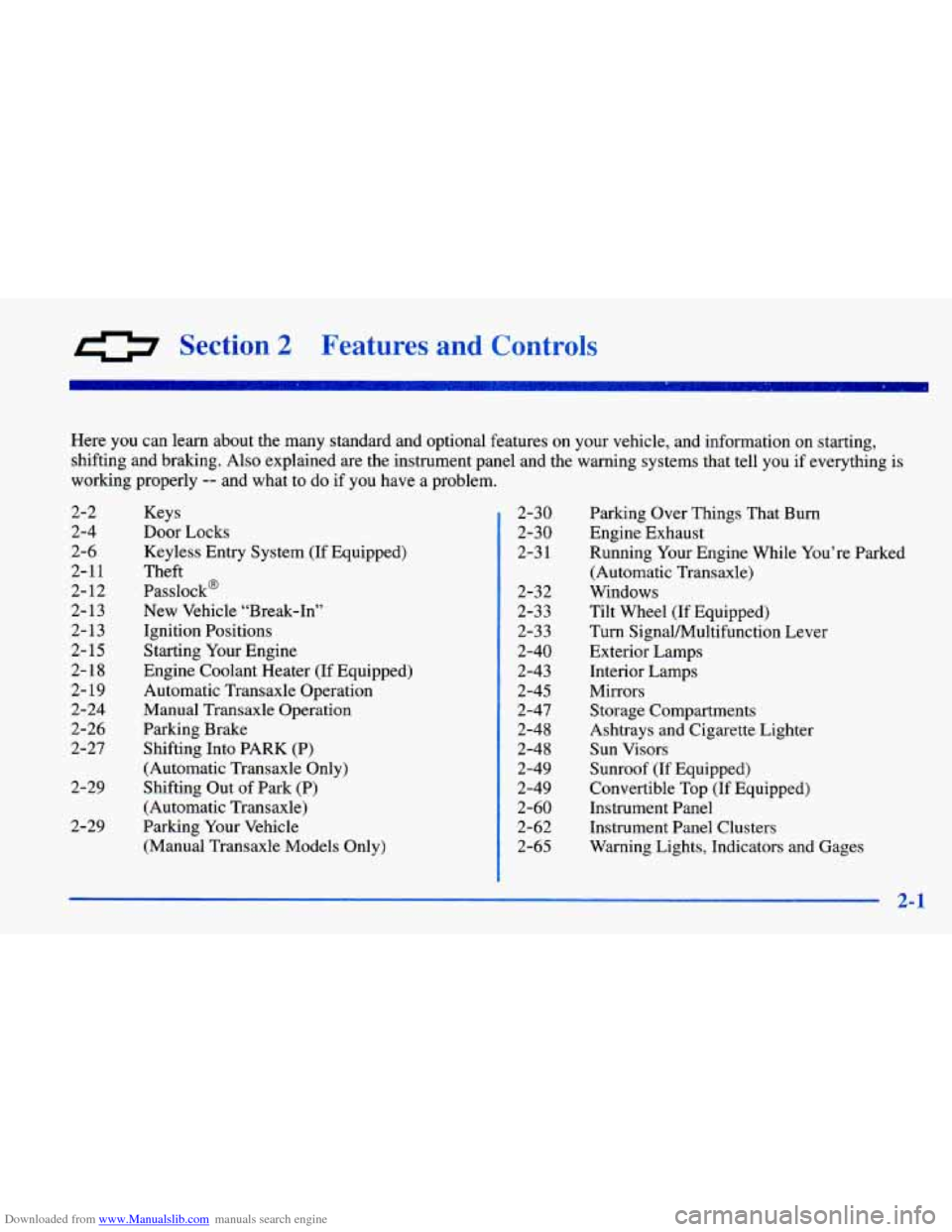
Downloaded from www.Manualslib.com manuals search engine 0 Section 2 Features and Controls
Here you can learn about the many standard and optional featur\
es on your vehicle, and information on starting,
shifting and braking. Also explained are the instrument panel and the warning systems that tell you if everything is
working properly
-- and what to do if you have a problem.
2-2
2-4
2-6
2-11
2- 12
2-13
2-
13
2- 15
2-18
2- 19
2-24
2-26
2-27
2-29
2-29
Keys
Door Locks Keyless Entry System (If Equipped)
Theft
Passlock@
New Vehicle “Break-In”
Ignition Positions
Starting Your Engine
Engine Coolant Heater (If Equipped) Automatic Transaxle Operation
Manual Transaxle Operation
Parking Brake
Shifting Into PARK (P)
(Automatic Transaxle Only)
Shifting Out of Park
(P)
(Automatic Transaxle)
Parking Your Vehicle
(Manual Transaxle Models Only)
2-30
2-30
2-3 1
2-32
2-33
2-33
2-40
2-43
2-45
2-47
2-48
2-48
2-49
2-49
2-60
2-62 2-65 Parking Over Things That Burn
Engine Exhaust
Running Your Engine While You’re Parked
(Automatic Transaxle)
Windows
Tilt Wheel (If Equipped)
Turn SignalMultifunction Lever
Exterior Lamps
Interior Lamps
Mirrors Storage Compartments
Ashtrays and Cigarette Lighter Sun Visors
Sunroof
(If Equipped)
Convertible Top (If Equipped) Instrument Panel
Instrument Panel Clusters
Warning Lights, Indicators and Gages
2-1